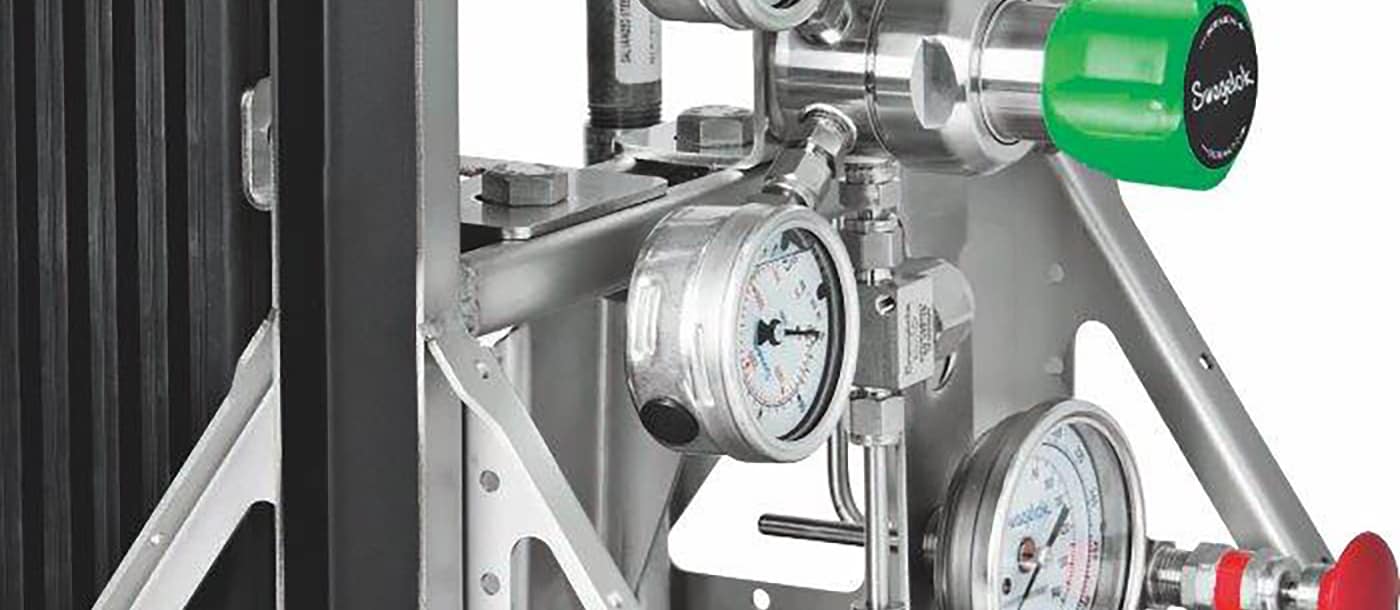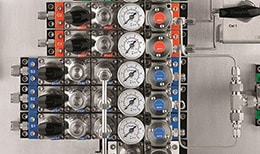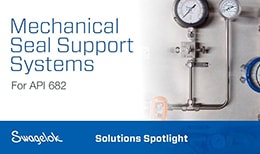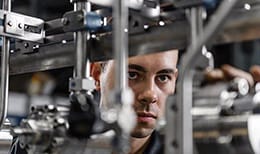
Swagelok® Schwebekörperdurchflussmesser
Schwebekörperdurchflussmesser von Swagelok für Gase und Flüssigkeiten gewährleisten gleichbleibende Genauigkeit. Je nach Anwendung haben Sie die Wahl zwischen Glas- oder Metallröhren.
Weitere Informationen anfordernSchwebekörperdurchflussmesser von Swagelok® messen den Durchfluss von Flüssigkeiten und Gasen mit einem konischen Rohr und einem Schwebekörper. Bei steigendem Durchfluss steigt der Schwebekörper auf, bei sinkendem Durchfluss wird er durch die Schwerkraft nach unten gezogen. Diese Durchflussmesser sind einfach zu installieren, leicht abzulesen und haben keine Verschleißteile, was den Wartungsaufwand minimiert. Mit einem Regelbereichsverhältnis von 10:1 (der kleinste Messwert beträgt ein Zehntel des vollen Skalenendwertes) ermöglichen sie genaue Messungen. Sie sind sowohl mit metrischer als auch mit US-Skala erhältlich und eignen sich für eine Vielzahl von Anwendungen und Einsatzorten.
Jeder Schwebekörperdurchflussmesser von Swagelok wird im Werk auf das angegebene Medium, den Durchflussbereich und die Genauigkeitsklasse mit sauberer, trockener Luft (Gasmodelle) bzw. Wasser (Flüssigkeitsmodelle) kalibriert. Sie können auch für anwenderspezifische Anwendungen kalibriert werden.
Schwebekörperdurchflussmesser der Serie M (Modelle M1, M2, M4 und M4H)
Die Durchflussmesser der Serie M von Swagelok® sind mit Metallmessrohren für den Einsatz unter schwierigen Bedingungen mit hohen Temperaturen oder hohem Druck ausgestattet. Da eine direkte Ablesung an Metallrohren nicht möglich ist, werden diese Modelle mit mechanischen oder elektronischen Anzeigen ausgestattet, um eine eindeutige und genaue Überwachung zu gewährleisten.
Spezifikationen der Modelle M1, M2, M4 und M4H
| Durchflussmessbereiche | Luft: 0,18 bis 1,8 und 670 bis 6700 std ft; 5,0 bis 50 und 18.000 bis 180.000 std L/h Wasser: 0,08 bis 0,8 und 270 bis 2700 U.S. gal/h; 0,3 bis 3,0 und 1000 bis 10.000 L/h |
| Temperaturbereiche | Prozess: M1, M2: –40 bis 150 °C (–40 bis 302 °F) M4, M4H: –40 bis 300 °C (–40 bis 572 °F) Umgebung: M1, M2: –20 bis 70 °C (–4 bis 158 °F) M4, M4H: –40 bis 120 °C (–40 bis 248 °F) |
| Max. Eingangsdruck | Bis 199 bar (2888 psig) |
| Prozessanschlüsse | 1/4 bis 1 1/4 Zoll NPT-Verschraubung; 1/2 bis 1 Zoll ASME-Flanschadapter |
| Genauigkeitsklasse | 1,6, 2,5, 4,0 |
Schwebekörperdurchflussmesser der Serie G (Modelle G1, G1, G2, G3, G4, GM und GP)
Modelle der Serie G von Swagelok® sind mit Glasmessrohren ausgestattet. Dies ermöglicht eine gute Sicht auf das Prozessmedium und eine direkte Durchflussmessung.
Spezifikationen der Modelle G1, G2, G3, G4, GM und GP
| Durchflussmessbereiche | Luft: 0,018 bis 0,18 und 18 bis 180 std ft; 0,5 bis 5,0 und 500 bis 5000 std L/h Wasser: 0,065 bis 0,65 und 4,2 bis 42 U.S. gal/h; 0,04 bis 0,4 und 16 bis 160 L/h |
| Temperaturbereiche | Prozess: –5 bis 100 °C (23 bis 212 °F) Umgebung: –20 bis 100 °C (–4 bis 212 °F) |
| Max. Eingangsdruck | Bis 10 bar (145 psig) |
| Prozessanschlüsse | 1/4 Zoll NPT-Verschraubung; G 1/8 (ISO 228); G 1/4 (ISO 228) |
| Genauigkeitsklasse | 1,0, 2,5, 4,0 |
Sie benötigen Hilfe bei der Wahl des richtigen Durchflussmessers?
Schwebekörperdurchflussmesser—Kataloge
Hier finden Sie ausführliche Produktinformationen zu Werkstoffen, Drücken und Temperaturen, Optionen und Zubehör.
Features: Glass and metal (armored) tube models, including miniature armored model; Highly accurate measurement even at very low flow, with individually calibrated scales based on flow tests; Flexible and adaptable to specific system requirements; High quality, durability, and repeatability; 1/8 to 1 1/4 in. process end connections

Kleines Gerät mit großem Potenzial: So ermitteln und vermeiden Sie Fehler bei Manometern
Erfahren Sie mehr über die Anzeichen von Manometerausfällen und reduzieren Sie so Sicherheitsrisiken für Ihre Mitarbeiter sowie kostspielige Ausfallzeiten und Reparaturen.
Manometerausfälle verhindernSwagelok-Ressourcen für Sie zusammengestellt

Tipps für eine repräsentative Probenahme in der Analysetechnik
In der Analysetechnik ist die Sicherstellung von repräsentativen Proben nicht immer einfach. Erfahren Sie von den Experten von Swagelok, wie Sie häufige Probleme bei der Probenahme erkennen und beseitigen, um jederzeit repräsentative Proben sicherzustellen.

Gleitringdichtungssysteme—Lösungen im Blickpunkt
Erfahren Sie, wie Gleitringdichtungssysteme von Swagelok® nach API 682 die Best Practices dieser Norm integrieren und sogar noch darüber hinausgehen—durch Anwendung von Konstruktionsprinzipien, die eine einfache Installation und Wartung der Systeme ermöglichen.

Wie Sie bei der Herstellung von Fluidsystemen ressourcenbedingte Einschränkungen minimieren können
Ein erfolgreicher und zuverlässiger Anlagenbetrieb steht und fällt mit den verwendeten Fluidsystemen. Wenn die Ressourcen knapp sind, kann sich die Beteiligung eines kompetenten Fertigungspartners schnell bezahlt machen.

Prozessmessungen—Best Practices rund um Impulsleitungen
Wenn man sich ausschließlich auf die Ausgabe des Messwertgebers konzentriert, kann es mitunter schwierig sein, Probleme in der Prozessinstrumentierung zu erkennen. Erfahren Sie, wie Sie Probleme in Ihrer Instrumentierungsleitung mit den Tipps und Best Practices von Swagelok einfach in den Griff bekommen.
